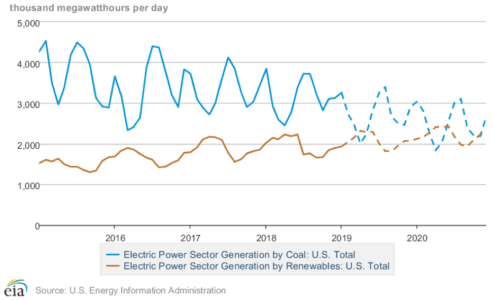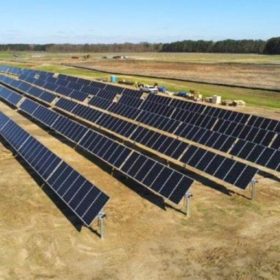King Coal is dying, and this month will see a new milestone in the decline of what was the largest source of electricity generation for the 20th century and even the first fifteen years of the 21st.
According to an analysis of the U.S. Department of Energy’s Energy Information Administration (EIA) by the Institute for Energy Economics and Financial Analysis (IEEFA), renewable energy sources including hydroelectricity are set to generate more electricity than coal, for the first time ever.
The analysis shows that renewables generate 2.32 and 2.27 terawatt-hours (TWh) in April and May, ahead of the 2.00 and 2.24 TWh anticipated to be generated by coal.

Short-term and long-term trends
There are two trends here that cause this crossover, and they operate on different timescales. First, as shown in the above chart, renewable energy generation always increases in spring, due to a rise in hydroelectric power as rivers swell, including from snowmelt. As such, IEEFA notes that spring is when many coal plants will shut down for maintenance, as power prices are lowest and they are least likely to be needed.
However, the longer-term trend is that coal is decreasing as a share of the U.S. electricity mix, and its fall has been particularly precipitous over the last five years. According to EIA coal still made up 39% of U.S. electricity generation as recently as 2014, but only 27% in 2018.
The main driver of this has been abundant, cheap natural gas due to the rise of hydraulic fracturing (“fracking”), and more electricity has been generated from gas-fired power plants than coal on an annual basis every year since 2015. However, wind and solar are also growing rapidly and allowing renewables to take up an increasing share of electricity generation. Wind and solar together made up 9% of U.S. electricity generation in 2018, up from only 1.6% in 2008.
Further transition
With no new coal plants being built and gas, wind and solar dominating new electricity generation, there is no end in sight for the decline of coal. in fact the question has not become whether or not these sources will replace coal, but rather how much gas-fired capacity will be built before gas is eclipsed by renewables, as is happening in California.
On the national scale, the aging coal fleet continues to retire. Not only does EIA predict that 7 gigawatts of coal additional coal plants will go offline by the end of 2020, but an analysis by Energy Innovation has shown that in 74% of cases it is cheaper to build new wind and solar than to keep running existing coal plants, and that this number will increase to 86% by 2025.
It will still take a few years for renewables to entire eclipse coal in the U.S. fleet, and in June it is expected that total coal-fired generation is going to surpass renewables again.
Until spring 2020. And some time in the next decade, you can expect these lines to cross over entirely.
This content is protected by copyright and may not be reused. If you want to cooperate with us and would like to reuse some of our content, please contact: editors@pv-magazine.com.









I’ve been saying for a while in the next couple yrs, RE will beat coal on a yrly basis in the US.
Nice to see it beating coal in the minimal generation season already.
I would like to add that EIA data from Dec 2018 had coal plant retirements of 0MW for Jan and 584MW for Feb this year. Instead 312MW retired in Jan and 1,943MW retired in Feb. So, total of 2,255MW vs EIA known of 584MW or 1,671MW more than EIA expected.
Let’s hope the trend continues.
John,
So true. The EIA only has visibility of announced retirements. At the same time an unknown number of players are bleeding red ink, deciding they can’t take it anymore, then stand up and throw in the towel.
With large scale PV PPAs coming in under 4 cents per KWh, and coal transport and remediation costs rising, many sovereign wealth and hedge funds are dumping coal assets from their portfolios. Now is time to retrain the 80,000 US miners for renewable energy jobs that will never give them black lung or foul their ground water. We will soon have similar breakthroughs in flow battery technology that will provide the baseload capacity coal plants have, making coal irrevocably uncompetitive. We used to use whale oil to light our homes. Coal oil and NG will soon be obsolete, since wind, sun and tide come to us FREE and without environmental consequence.